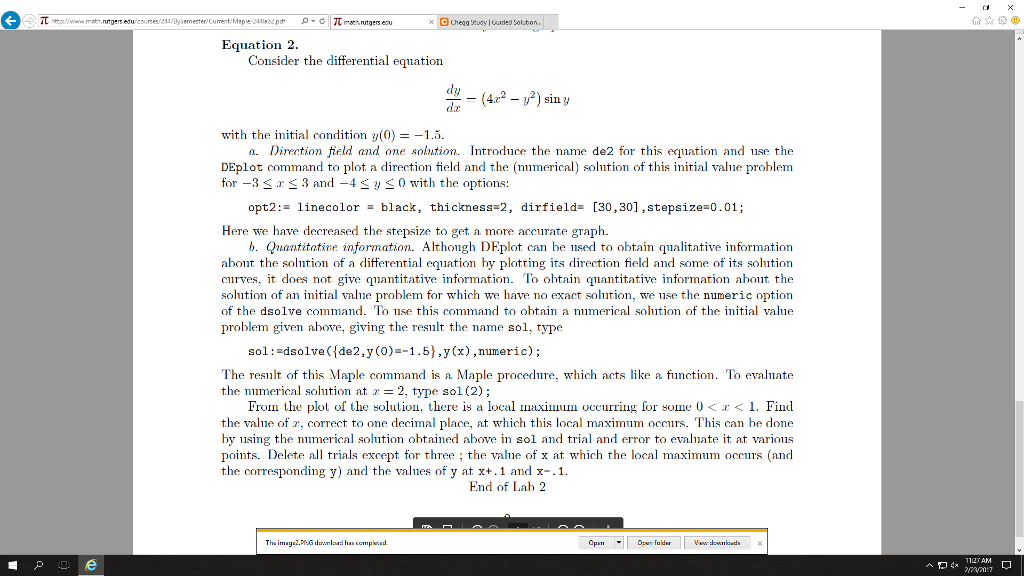Answered step by step
Verified Expert Solution
Question
1 Approved Answer
Need help with Maplelab problem nrgersed TT math. hegg study Gulded Solute Equation 2 Consider the differential equation dy dar with the initial condition y



Need help with Maplelab problem
nrgersed TT math. hegg study Gulded Solute Equation 2 Consider the differential equation dy dar with the initial condition y a. Direction field and one solution. Introduce the name de2 for this equation and 11se the DEplot command to plot a direction field and the (numerical) on of this initial va e problem for -3 s 3 and 4 y 0 with the options opt2 linecolor blac thickness 2. dirfield [30,301 stepsize 0.01 Here we have decreased the stepsize to get a more accurate graph b. Quantitative information. Although DEplot can be used to obtain qualitative information abont the solution of a differential equation by plotting its direction field and some of its solution curves, it does not give quantitative information. To obtain quantitative information about the solution of an initial valme problem for which we have no exact solution, we se the numeric option of the dsolve command. To se this command to obtain a numerical solution of the initial value problem given above, giving the res t the name sol, type sol: dsolve(fde2, y -1.5 ,y (x),numeric) (0) e result of this Maple command is a Maple procednre, which e a function. To eval ate the numerical solution at 2, type sol (2) From the plot of the solution, there is a local maxinuum occurring for some 0 1. Find the valme of T, correct to one decimal place, at which this local maximum occurs. This can be done by using the numerical solution obtained above in so and trial and error to eval ate it at various 1 points. Delete all trials except for three the value of x at which the local maximum occurs (and the corresponding y) and the val es of y at x 1 and x End of Lab 2 nrgersed TT math. hegg study Gulded Solute Equation 2 Consider the differential equation dy dar with the initial condition y a. Direction field and one solution. Introduce the name de2 for this equation and 11se the DEplot command to plot a direction field and the (numerical) on of this initial va e problem for -3 s 3 and 4 y 0 with the options opt2 linecolor blac thickness 2. dirfield [30,301 stepsize 0.01 Here we have decreased the stepsize to get a more accurate graph b. Quantitative information. Although DEplot can be used to obtain qualitative information abont the solution of a differential equation by plotting its direction field and some of its solution curves, it does not give quantitative information. To obtain quantitative information about the solution of an initial valme problem for which we have no exact solution, we se the numeric option of the dsolve command. To se this command to obtain a numerical solution of the initial value problem given above, giving the res t the name sol, type sol: dsolve(fde2, y -1.5 ,y (x),numeric) (0) e result of this Maple command is a Maple procednre, which e a function. To eval ate the numerical solution at 2, type sol (2) From the plot of the solution, there is a local maxinuum occurring for some 0 1. Find the valme of T, correct to one decimal place, at which this local maximum occurs. This can be done by using the numerical solution obtained above in so and trial and error to eval ate it at various 1 points. Delete all trials except for three the value of x at which the local maximum occurs (and the corresponding y) and the val es of y at x 1 and x End of Lab 2Step by Step Solution
There are 3 Steps involved in it
Step: 1

Get Instant Access to Expert-Tailored Solutions
See step-by-step solutions with expert insights and AI powered tools for academic success
Step: 2

Step: 3

Ace Your Homework with AI
Get the answers you need in no time with our AI-driven, step-by-step assistance
Get Started


